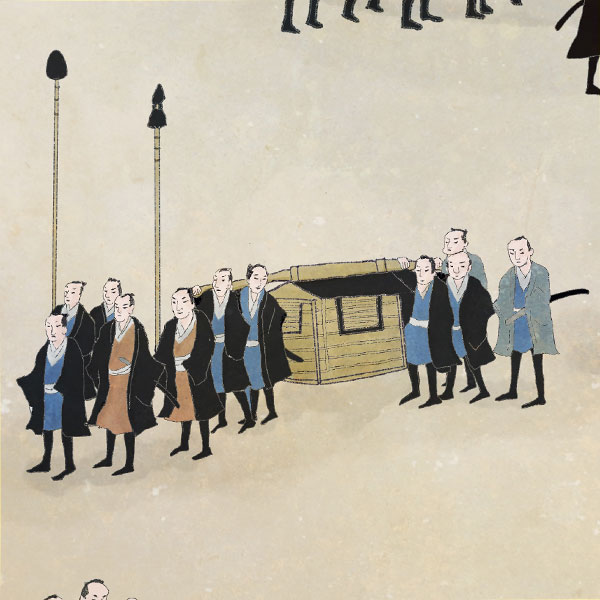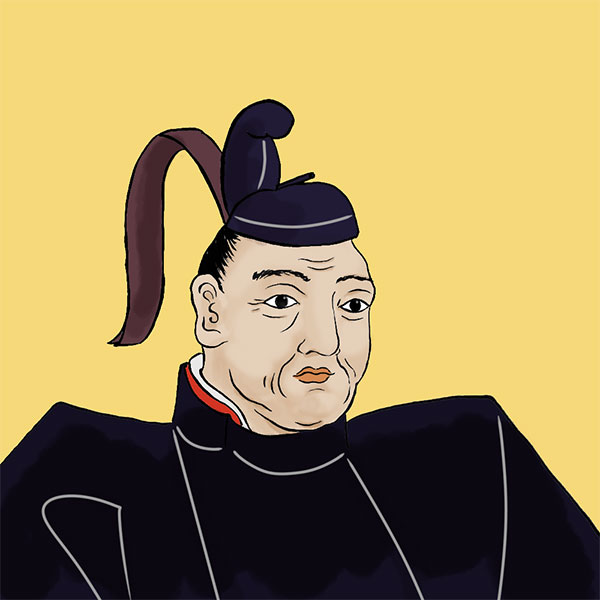Sankin rotation (1/2)Daimyo procession and financial difficulties

sankin katai
- Article category
- case file
- Incident name
- Sankin Kotai (1635-1867)
- place
- Tokyo
- Related castles, temples and shrines

Edo castle
- people involved
Sankinkotai is a festival in which a procession of feudal lords travels between Edo and Kunimoto. Each domain held a splendid daimyo procession with great pride to demonstrate its authority, which led to the development of highways and post towns, but it is also known that each domain fell into financial difficulties due to huge expenses. Why did the Edo shogunate implement sankin kotai? What was sankin kotai in the first place? This time, I will explain sankin kotai in an easy-to-understand manner while digging deeper.
What kind of system is sankin katai?
Sankin-tatai is known as a system from the Edo period. Its origin is Obanyaku, which existed during the Kamakura period. The Ōbanyaku was a guard role in the Imperial Palace, Imperial Palace, and Kyoto City, and Gokenin took turns in serving as the Ōbanyaku in Kamakura and Kyoto.
A further development of this was during the Muromachi period when shugo daimyo lived in Kyoto and served the shogun. This was a measure to strengthen the master-servant relationship and prevent rebellion, but even during the Sengoku period, a system similar to sankin-tatai existed, in which daimyo had their vassals live nearby. Toyotomi Hideyoshi also had his subordinates and their wives and children live in Osaka and Fushimi.
Tokugawa Iemitsu institutionalized sankin kotai
When Tokugawa Ieyasu established the Edo shogunate, the feudal lords sent their wives and children to live there as hostages to pledge their loyalty, and the feudal lords, mainly from eastern regions, began to visit Edo Castle every year. A system similar to the sankin kotai of the Sengoku period continued even after the opening of the government.
When the Toyotomi family remained in Osaka, feudal lords also worked in Osaka, but after the Toyotomi family was destroyed in the summer campaign in Osaka in 1615, they actively worked in Edo. It will look like this. Under the second shogun, Hidetada Tokugawa, feudal lords kept their wives and children in Edo and came to work every other year.
The sankin katai system was institutionalized during the era of the third generation, Tokugawa Iemitsu. Iemitsu revised the samurai laws in 1635 (Kanei Rei). At that time, we have clearly stated that there will be attendance shifts. The plan was to require Tozama daimyo to conduct sankin kotai every April. Representatives of Tozama Daimyo include the Maeda family of the Kaga domain (present-day Ishikawa prefecture, Toyama prefecture, etc.), the Shimazu family of the Satsuma domain (Kagoshima prefecture, southwestern Miyazaki prefecture), and the Date family of the Sendai domain (Miyagi prefecture, Iwate prefecture, Fukushima prefecture, etc.). can be given. In 1642, the scope was expanded to include feudal lords and Fudai daimyos (*Fudaimyo dates are June or August every year).
What is the purpose of sankin kotai?
The main purpose of sankin katai was to strengthen and clarify the master-servant relationship between daimyo and shogun. It also had the meaning of preventing rebellion by taking hostages. There is a theory that ``sankin-tatai was done to reduce the economic power of daimyo and prevent them from revolting,'' but at the time of Tokugawa Iemitsu's ``Kanei Rei,'' the fact that the number of daimyo processions for sankin-tatai was too large is considered problematic. The shogunate is requesting that the number of servants be reduced because the expenses are too high and the burden on the people of the territory is heavy.
The number of sankin kotai was determined by the size of each domain. As of 1721, a daimyo with 10,000 koku can have up to 54 people, 50,000 koku can have up to 167 people, 100,000 koku can have up to 240 people, and over 200,000 koku can have up to 450 people. I am. However, as I will explain later, the daimyo procession required a large number of people due to the large amount of luggage, and in reality it was difficult to maintain the line as per the regulations.
Furthermore, the daimyo procession for sankinkotai was a great opportunity to show off the power of the daimyo at home and abroad, so the daimyo did their best to show off and put together a spectacular procession. During the time of Maeda Tsunori, the fifth generation lord of the Maeda clan of the Kaga domain, known as Kaga Hyakumangoku, the line was filled with 4,000 people. However, as I will explain later, I didn't travel in large groups for the whole trip, but only when I left and arrived at Kunimoto and Edo.
Because of this, the daimyo fell into debt hell due to sankinkotai and suffered from financial difficulties.
Daimyo who were “exceptions” to sankin kotai
Due to the sankin katai, daimyo lived in Edo for one year and then spent another year in Kunimoto. However, there were quite a few daimyo who were not eligible for sankin kotai. Those who hold positions in the shogunate, such as roju or young yori, are not eligible because if they return to their province, they will interfere with political affairs. The Mito domain and the three Tokugawa lords, who were permanently stationed in Edo, were also excluded. Furthermore, small domains such as those with 10,000 koku were allowed to stay permanently in Edo because it was difficult for them to bear the financial burden of sankin kotai.
In addition, in the event of an emergency such as the feudal lord's illness or a major famine in the country, the sankin kotai is exempted. Young feudal lords were also excluded.
There were also exceptions to the time period. Fudai daimyo in the Kanto region used to do so every six months, while daimyo from far away places, such as Matsumae Domain (Hokkaido), held it once every three years, and Tsushima Domain (Nagasaki Prefecture), Souji, once every five or six years. One reason for this was that the Matsumae clan was responsible for guarding Ezo, and the Tsushima clan was responsible for diplomatic and trade affairs with Korea.
Process of sankin kotai ① Check your belongings in preparation for departure
Now, let's take a look at the actual flow of sankin kotai. First, the daimyo submits a request for sankin kota to the shogunate, receives a written order from the shogunate instructing the timing of sankin, then begins preparations, decides on a route, and submits it to the shogunate.
Next, we will select participants for the sankin kotai, find accommodations along the way, and prepare our belongings. As for lodging facilities, there is a ``honjin'' in the post town for the daimyo, and a ``hatagoya'' where the feudal retainers stay. If you have a large group, you may also use nearby temples or post towns before and after. In some cases, the timing was different, so in the case of the Tokaido route, where many daimyo processions pass, reservations were made six months in advance.
In addition to weapons, the items you bring include cooking utensils for the cook who accompanies you, and ingredients such as rice, salt, and soy sauce. They also carried pickles with pickle stones. This is to prevent the lord from being poisoned. However, it must have been extremely difficult to transport the people.
Also included in the procession were portable baths and toilets (including their contents), recreational equipment such as Go and Shogi, and falconers and falcons. There is also a record of the Kishu Tokugawa family even carrying an iron plate to protect the lord's bed when they changed their positions.
When preparations are made for departure, the daimyo visit temples and shrines to pray for safety on the journey. And now it's time to leave!
Flow of sankin kotai ② Departing from paying in advance
Now, it's finally the start of the Sankin Exchange. Let's take an example of traveling from Kunimoto to Edo. There is a foot at the front of the line that "pays in advance" to let people know that the line is passing. There is an image that the people of the territory will kneel on the ground when the Sakipay shouts, ``Shimo-nii, Shimo-nii,'' but this is limited to the three Tokugawa families and the three lords of the Tokugawa clan. Usually, people shouted ``Get down'' and ``Move over!'' and people moved to the side of the road to avoid getting in the way of the procession.
It is said that ``No one except midwives and carriers are allowed to cross the daimyo procession; if they do so, it will be considered disrespectful,'' but if the procession was too long, a space was sometimes created for them to cross. Additionally, there were almost no cases of people being dismissed for disrespectful behavior, and in most cases it seems that children were given a strict warning.
In the procession, ashigaru and nakama, who carry bows, spears, and sometimes guns, form the vanguard. Next is the main shrine, which is centered around the basket where the daimyo is located, followed by cavalry, samurai guards, people carrying clothing, medicine, rain gear, etc., and finally the transport corps carrying luggage. In principle, daimyo rode in palanquins, but it seems that they sometimes walked or rode horses.
The daimyo procession was spectacular, with the spear-bearers at the front of the procession sometimes putting on performances by throwing long spears at each other and spinning them around. But if you want to be seen by a lot of people...
Flow of sankin kotai ③ The beginning and end are gorgeous
Yes, there is a ulterior motive behind the daimyo procession. When departing from and arriving at Kunimoto or Edo, a large number of people appear to emphasize the greatness of the domain, but in reality, they employ temporary extras. Other than that, in order to adhere to the routes and dates and times set by the shogunate, they specialize in moving, reducing the number of people, and moving forward.
There is a continuation of the article on sankin kotai.
- people involved

- WriterNaoko Kurimoto(Writer)I am a former travel industry magazine reporter. I have loved history, both Japanese and world history, since I was a child. I usually enjoy visiting temples and shrines, especially shrines, and often do ``pilgrimages to sacred places'' themed around historical figures. My favorite military commander is Ishida Mitsunari, my favorite castle is Kumamoto Castle, and my favorite castle ruins is Hagi Castle. My heart flutters when I see the ruins of battle castles and the stone walls of castle ruins.




